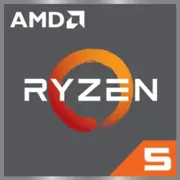AMD Ryzen 5 7500F

AMD Ryzen 5 7500F: Detailed Review and Practical Tips for Building a PC
Processor for Gamers and Enthusiasts, or Why Move to AM5?
1. Key Specifications: Raphael Architecture and Key Features
The AMD Ryzen 5 7500F is part of the Zen 4 lineup, built on the Raphael architecture. This is AMD's first chip for the AM5 socket, released using the 5nm TSMC FinFET process, which provides high energy efficiency and performance improvements compared to previous generations.
Specifications:
- 6 Cores / 12 Threads — optimal for gaming and multitasking.
- Base Clock: 3.7 GHz, max — up to 5.0 GHz (Precision Boost).
- L3 Cache: 32 MB — twice that of the Ryzen 5 5600X (Zen 3).
- TDP: 65 W — low power consumption for its class.
- Benchmarks: Geekbench 6 Single-Core — 2781, Multi-Core — 12850. For comparison, the Ryzen 5 7600X (without the F suffix) scores around 2900/13500 but is more expensive.
Key Features:
- Support for PCIe 5.0 — future-proof for graphics cards and NVMe.
- EXPO technologies for memory overclocking and PBO (Precision Boost Overdrive).
- No integrated graphics (F suffix) — the chip is aimed at users with discrete GPUs.
2. Compatible Motherboards: AM5 Socket and Selection Tips
The Ryzen 5 7500F uses the AM5 socket, which signifies a transition to a platform that supports DDR5 and PCIe 5.0.
Chipsets:
- X670E — high-end option: overclocking, 2 PCIe 5.0 slots, maximum ports (suitable for builds with RTX 4090 and multiple NVMe).
- B650 — "golden mean": 1 PCIe 5.0 slot for GPU or SSD, supports overclocking (example: MSI B650 Tomahawk).
- A620 — budget options: no overclocking, but suitable for office PCs or systems with mid-range graphics cards (e.g., RX 7600).
Important:
- All AM5 motherboards have only DDR5 slots — DDR4 is not supported.
- Pay attention to the VRM module when selecting (at least 12+2 phases recommended for stable operation).
3. Supported Memory: DDR5 and Optimization
The Ryzen 5 7500F works exclusively with DDR5, boosting bandwidth to 4800-6000 MT/s.
Recommendations:
- Optimal frequencies: 5200-6000 MHz (for example, Kingston Fury Beast DDR5-6000).
- Use modules with EXPO profiles for automatic overclocking (AMD's equivalent of XMP).
- Dual-channel mode is mandatory — install 2 modules (e.g., 2x16 GB).
Practical Example:
A build based on the Ryzen 5 7500F and G.Skill Trident Z5 Neo (DDR5-6000) shows a +15% increase in fps in games compared to DDR5-4800.
4. Power Supplies: Power Calculation
With a TDP of 65 W, the processor has modest power consumption, but the choice of PSU depends on the graphics card:
- For RTX 4060 / RX 7600: a 500-600 W PSU is sufficient (for example, Corsair CX650).
- For RTX 4070 Ti / RX 7900 XT: choose 750-850 W (Be Quiet! Pure Power 12 M 750W).
- Always opt for PSUs with an 80 Plus Bronze/Gold certification and overload protection.
Tip: Don't skimp on cables — modular PSUs (like the Cooler Master MWE Gold) will simplify assembly.
5. Pros and Cons of Ryzen 5 7500F
Pros:
- High IPC (instructions per clock) thanks to Zen 4.
- Low heat output — even the stock cooler handles it, but a tower cooler is better for overclocking.
- Support for PCIe 5.0 and DDR5.
Cons:
- No iGPU — unsuitable for office PCs without a graphics card.
- DDR5 and AM5 motherboards are more expensive than DDR4 counterparts.
6. Use Cases: Gaming, Video Editing, Streaming
- Gaming: At Full HD / 1440p, the processor can fully utilize the RTX 4070 or RX 7800 XT. In Cyberpunk 2077 — stable 90+ fps.
- Work Tasks: Rendering in Blender, editing in Premiere Pro — 12 threads handle tasks faster than an Intel i5-13400F.
- Streaming: NVENC from the graphics card + 6 cores are sufficient for streaming in OBS without lag.
7. Comparison with Competitors
- Intel Core i5-13400F: Cheaper but lags in single-threaded tasks (Geekbench 6 Single-Core — ~2400). However, it supports DDR4.
- Ryzen 5 7600: 5-10% more powerful but more expensive. The choice depends on the budget.
8. Practical Building Tips
1. Cooling: The stock Wraith Stealth cooler is adequate for stock frequencies. For overclocking — consider the DeepCool AK400.
2. Motherboard: For an RTX 4080, choose B650 with PCIe 5.0 x16.
3. BIOS: Update before installing the processor (some A620 boards may have "out of the box" issues).
9. Final Conclusion: Who is the Ryzen 5 7500F Suitable For?
This processor is an ideal choice for:
- Gamers looking to build an AM5 PC with future-proofing.
- Enthusiasts prioritizing energy efficiency and PCIe 5.0.
- Budget-conscious Editors — 6 cores are sufficient for most tasks.
Why this one? The best price-to-performance ratio in the $200-250 segment. If integrated graphics and DDR4 support are not needed — this is your option.
Build Smart: AM5 promises support until 2025, which means the Ryzen 5 7500F is just the beginning of your upgrade.
Basic
CPU Specifications
Memory Specifications
GPU Specifications
Miscellaneous
Benchmarks
Compared to Other CPU
Related CPU Comparisons
Share in social media
Or Link To Us
<a href="https://cputronic.com/cpu/amd-ryzen-5-7500f" target="_blank">AMD Ryzen 5 7500F</a>


